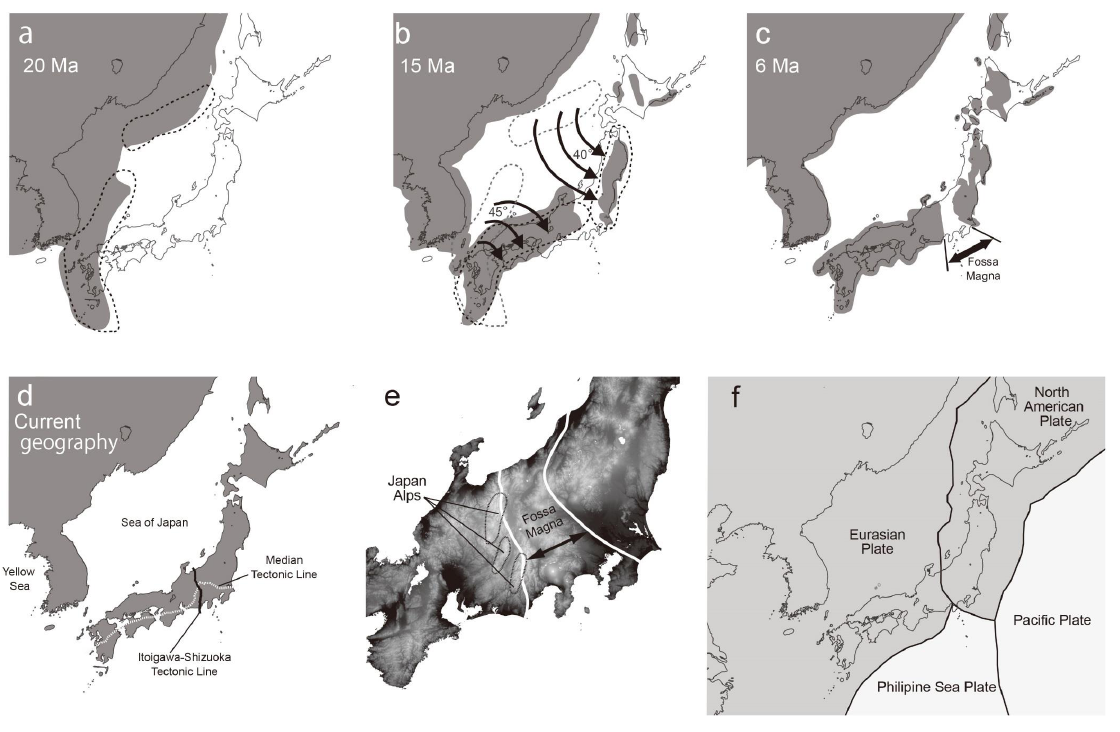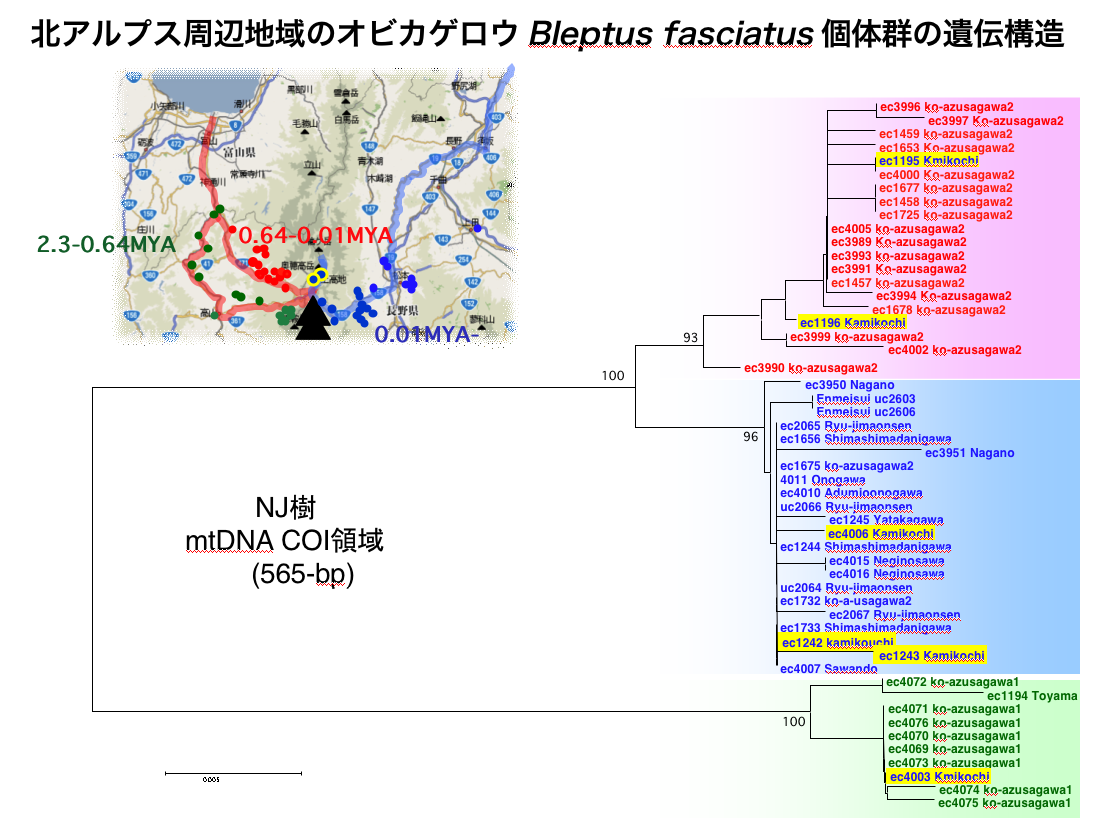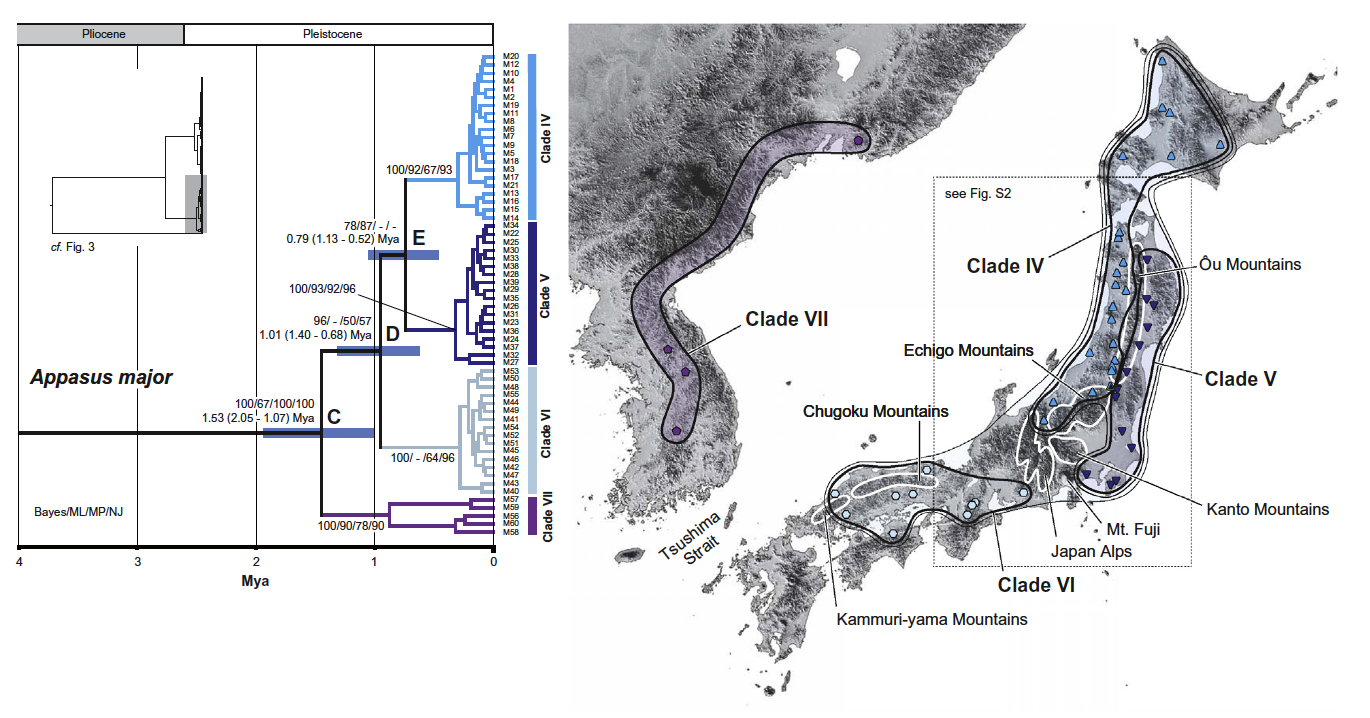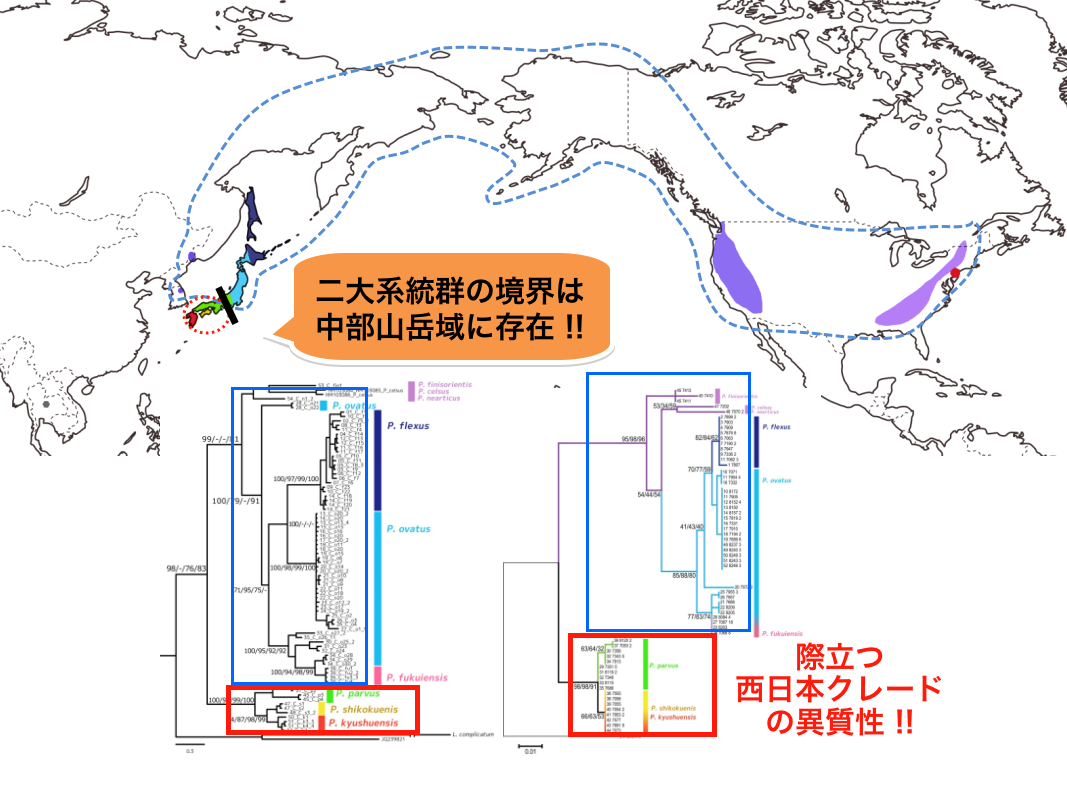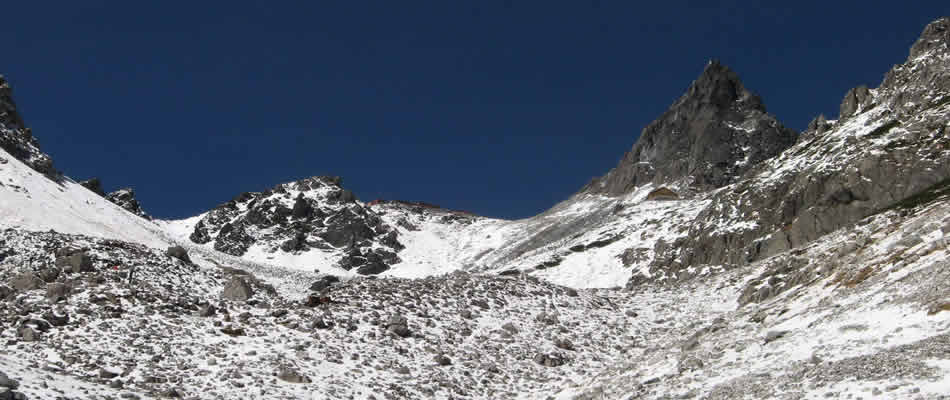
The Chubu Mountain Region is a Biodiversity Hot Spot Among Such Hot Spots Around the World
The Japanese Archipelago is described as a biodiversity hot spot region. About 25 million years ago the Japanese Archipelago was formed the eastern edge of the Asian Continent, and over a long period of time was torn from the continent to form the archipelago. It is a so-called “Continental Island”. Secondarily, it is also composed of “Oceanic Islands” formed by the eruption of undersea volcanoes around the Japanese Archipelago, such as the Ogasawara Islands and the Izu Islands.When oceanic islands are formed there is initially no biota present, whereas on the other hand, a continental island starts out with a portion of the biota that existed at the time of tearing away from the continent, so the biota of a continental island is regarded as a “Branch (Satellite) of the Continent”. However, the biodiversity of the Japanese Archipelago is unespectedly high, and so is considered to be a “World Biodiversity Hot Spot”. How did this come to be?
Various factors can be considered, but it is thought that the location of the archipelago and its complex geological history as listed below have had a strong effect.
(1) There is plentiful water as a result of the Asian monsoon climate, so its forests are well developed
(2) The archipelago extends north and south running through multiple biomes (Note 1)
(3) There are many dispersion routes in multiple directions such as via Kamchatka (north-east), Sakhalin (north), the Korean Peninsula and Mainland China (west), and from South-east Asia via Taiwan to the Ryukyu Islands
(4) East Japan and West Japan independently seperated from the Asian continent (as per the “Double-Door Opening” theory: see Fig. 1).
(5) Severe crustal movements are caused by 4 large plates (Pacific Plate, Philippine Sea Plate, Eurasian Plate, North American Plate) jostling against each other.
It is almost certain that each of the life forms on this archipelago have been affected to a greater or lesser degree by its complex geological history. As a result such history must have been reflected in their genes. Against this background the concept that “the complex geological history of the Japanese Archipelago and the phylogenetic structure of its life forms as being related” has been born.
In the Japanese Archipelago where even now severe crustal movements occur, mountain formation has occurred in a comparatively recent geological time frame. The history of evolution in comparatively recent times can be unraveled with greater accuracy than that of the evolutionary history of much older times. In other words, the Japanese Archipelago is an ideal field for researching the association between geological and phylogenetic history, so research into phylogenetic geography cinsucted within the Japanese Archipelago maaximizes the unique advantages of the Japanese Archipelago.
Fig. 1 Origin of the Japanese Archipelago (“Double Door Opening” theory and “Fossa Magna”)
The Japanese Archipelago was formed by the tearing of East Japan and West Japan independently from the eastern edge of the Asian continent in similar manner to the opening of double doors. It has been shown from research into paleo magnetism that East Japan has rotated counterclockwise, and West Japan has rotated clockwise. Also, it is believed that in the period up to about 5 million years ago the intersecting region between the two had been below sea level. This area is referred to as the Fossa Magna (deep trench), and a strong association has been found between this and the genetic divisions observed between East and West Japan. The figure is from Saito and Tojo (submitted).
(注1) バイオーム(Biome)とは、気候的特性によって区分された地域(ツンドラ・熱帯降雨林など)に生息する生物群集の単位(生物群系)
River Capture as a Result of Mountain Formation, and Deeply Related to Genetic Structure of Aquatic Insects
- Discovering Evidence from the DNA Analysis of Aquatic Insects of the Kamikochi region within Azusa-gawa River System -
Kamikochi is one of Shinshu’s characteristic natural features. The Azusa-gawa River flows through Kamikochi collecting water from 3,000m high steep mountains, and flows into the Matsumoto Basin. The contrast between the precipitous range of peaks in the background (e.g., Mt. Yari-gatake, Mt. Hotaka-dake) and the gently flowing Azusa-gawa River is said to be one of the attractions of Kamikochi.In recent years, as a result of the geological researches of Professor Harayama of the Institute of Mountain Science, it has been found that up to about 12,000 years ago the old Azusa-gawa River primarily flowed into the Miya-gawa/Takahara-gawa River of the Jinzu-gawa River system on the Hida-Takayama side of Northern Japan Alps. Due to either mountainforming activity by the Mt. Yake-dake volcanic mountains collapse, (1) the old Azusa-gawa River that flowed into the Miya-gawa – Jinzu-gawa River (before about 640,000 years ago),and (2) changed its flow route to the Takahara-gawa – Jinzu-gawa River (about 640,000 to 12,000 years ago), then (3) flowed down towards Matsumoto as at present, producing a river capture between the Azusa-gawa – Sai-gawa – Chikuma-gawa River (i.e., the Shinano-gawa River System). In the process between (2) and (3), it is considered that the old Azusa-gawa River became blocked and formed a giant natural dam lake and the stones and gravel deposited in the bottom of the lake is the origin of flat geological formation of present Kamikochi.
This geological history has naturally had a great effect on the biological species living in this area. Therefore, an analysis has been carried out of the genetic structure of the aquatic insect Bleptus fasciatus, which has inhabited all the water systems of the region for a long period of time (it became established at least several tens of thousands of years ago), and which is considered to have extremely weak dispersion capability. The results have shown that there are large genetic differentiations between the 3 rivers that were involved in the Azusa-gawa River capture. In addition, it was found that the Bleptus fasciatus inhabiting Kamikochi region that was connected to each of these has multiple genetic structures of these regions (Fig. 2).
Fig. 2 The phylogeography of Bleptus fasciatus
This is an actual example of river capture and genetic division observed in the southern part of the Northern Japan Alps (a range of peaks from Mt. Yari-gatake to Mt. Hotaka-dake). Bleptus fasciatus, which has adapted to the narrow streams of the headwater regions of rivers, exhibits major genetic differentiation between the Hida side (Miya-gawa River, Takahara-gawa River) and the Matsumoto side (Azusa-gawa River) of the Northern Japan Alps (the colors on the molecular phylogenetic tree and the colors of the sampling points correspond). Bleptus fasciatus from each of these river systems has been found within Kamikochi. The figure is from Tojo et al. (in prep.).
Creation of Genetic Diversity Within Species by Mountain Formation
- Genetic Differentiation Between Populations by Mountain Formation -
As a result of analysis of the genetic structure of various fauna groups mainly in the East Asian region including the Japanese Archipelago, it has gradually become clear than there is remarkable agreement between geological history and genetic structure. In particular, the analysis results for insects and freshwater fish inhabiting rivers are extraordinary. This is considered to be because creatures inhabiting rivers are forced to move and disperse in water systems that form a linear network, in contrast to the majority of living creatures that can disperse in a planar manner, so their degree of dispersion is lower.Many examples of genetic differentiation between populations (within species) caused by formation of straits or mountains have also been accumulated (Fig. 3). Also, by accumulating high accuracy analyses of various groups of species, it has become clear that initially nobody can be assumed. Not only the originally postulated dispersion from the Asian continent to the Japanese Archipelago occurred ("Downstream Dispersal"), but also the "Back Dispersal" has also been occured. That is, several lineages, which were diversified within the Japanese Archipelago, have confirmed to be such as to disperse the Asian Continent again.
Fig. 3 The genetic structure and phylogeography of Appasus major
Significant genetic divisions can be observed, such as the genetic division between the Japanese Archipelago and the Asian continent via the Korean Strait, the genetic division between the Japan Sea side and the Pacific Ocean side of the Ou Mountain range, and the genetic division between the Eastern and Western foothills of the Chubu Mountains. The figure is from Suzuki, Kitano and Tojo (2014), Mol. Phylogenet. Evol.
The Mountainous Regions of the Japanese Archipelago are an “Laboratory for Evolutionary Biology”
- Prospects for the Future -
As stated previously, the Japanese Archipelago with its complex geological history and as a hot spot of biodiversity has great potential as a platform for the study of phylogenetics and phylogeography. In particular the Chubu Mountain region is the most important region, as this is where ancient landmasses of East and West Japan meet, impacting against each other. Although the division of species groups on either side of the ridge line of mountains resulting from mountain formation activity has long been considered theoretically, the fact is that there have been very few cases that have been studied and explained in detail.We wish to accumulate research results utilizing the advantages of the Japanese Archipelago, where even today drastic crustal movements continue, a rare opportunity in world terms. Thereby, from here in “Shinshu”, we hope to begin to provide the unique research results available to us here to the world (for example, see Fig. 4).
Such research results have been published in the American specialist journal of molecular phylogenetic (Molecular Phylogenetics & Evolution) and in the British specialist journal of biology (Biological Journal of the Linnean Society), and other publications (Suzuki et al., 2013, 2014; Sekine et al., 2010a, b, 2013; Kato et al., 2013). This research has been supported with grants including: the Grants-in-Aid for Scientific Research for Young Scientists A (20687005) and Grants-in-Aid for Challenging Exploratory Research (23657064, 26650160).
Fig. 4 The molecular phylogeography of Palaeagapetus species
This figure shows the molecular phylogeographic analysis results for the total of 9 species of Palaeagapetus caddisflies that exist in the world. The blue monophyletic lineage “North American continent (Appalachian Mountains and Rocky Mountains) + Asian continent (Russian coast) + Sakhalin + Eastern Japan”, and the red monophyletic lineage “the Western Japan” are strongly supported, respectively. The boundary between these two lineages on a world-wide scale corresponds to the Chubu Mountain region. From Araiya, Ito, and Tojo (in prep.).


